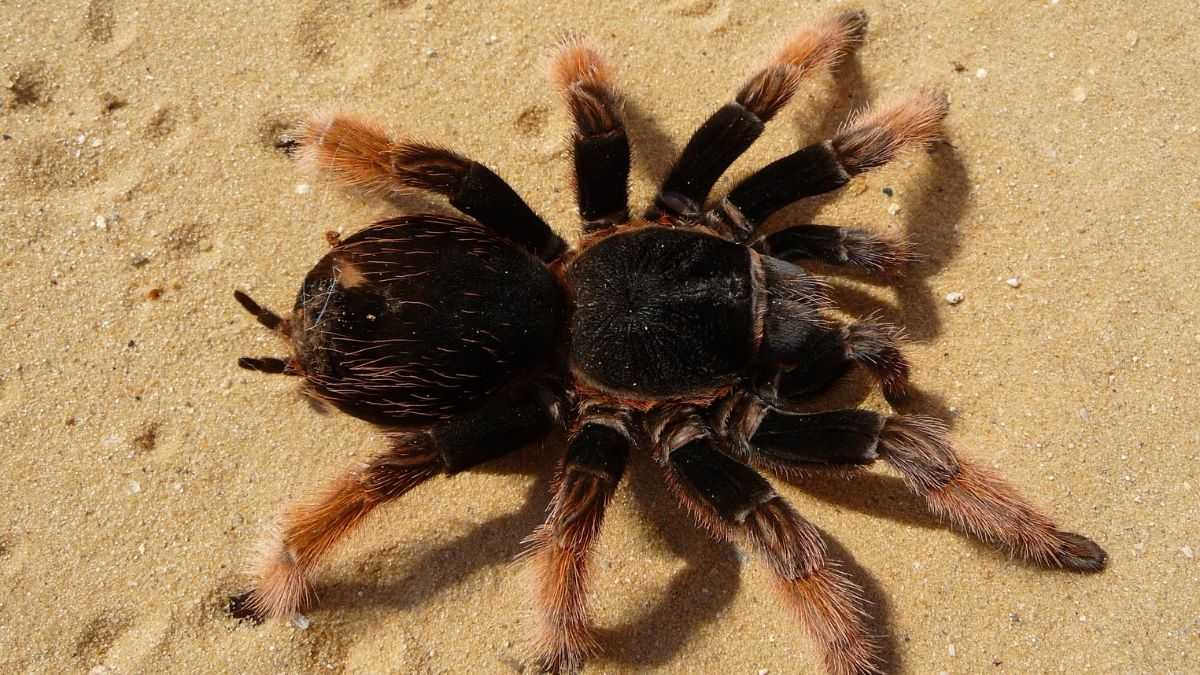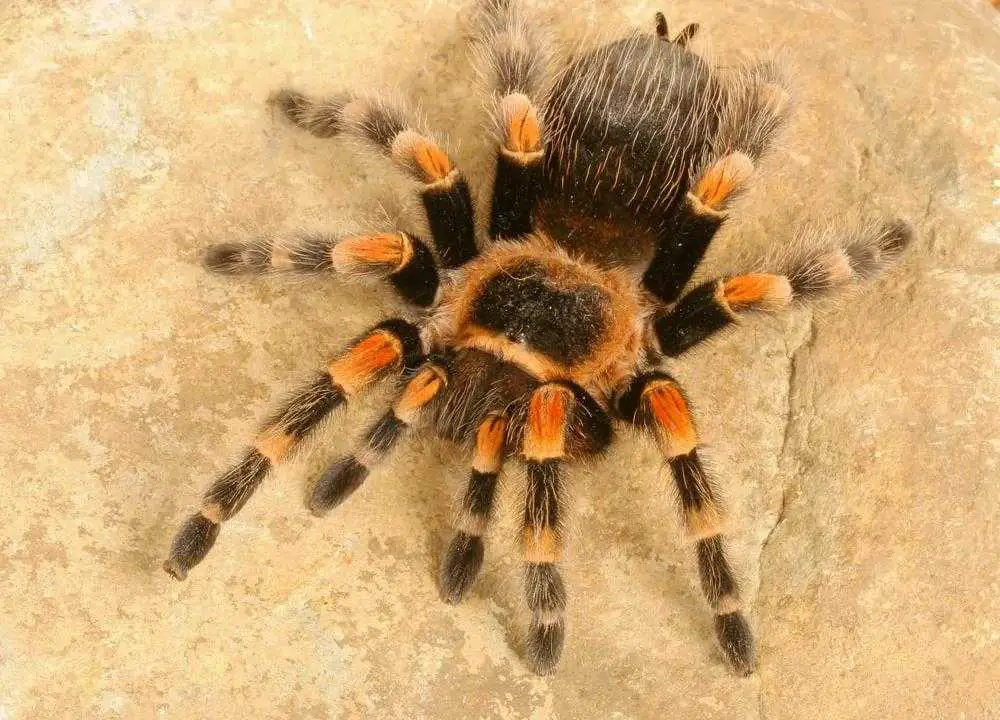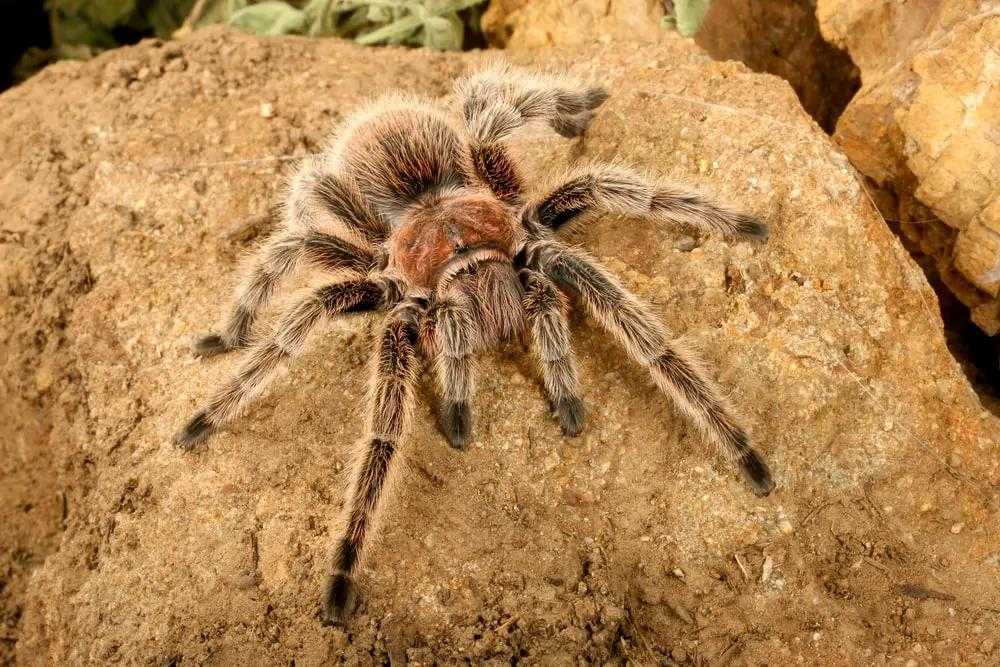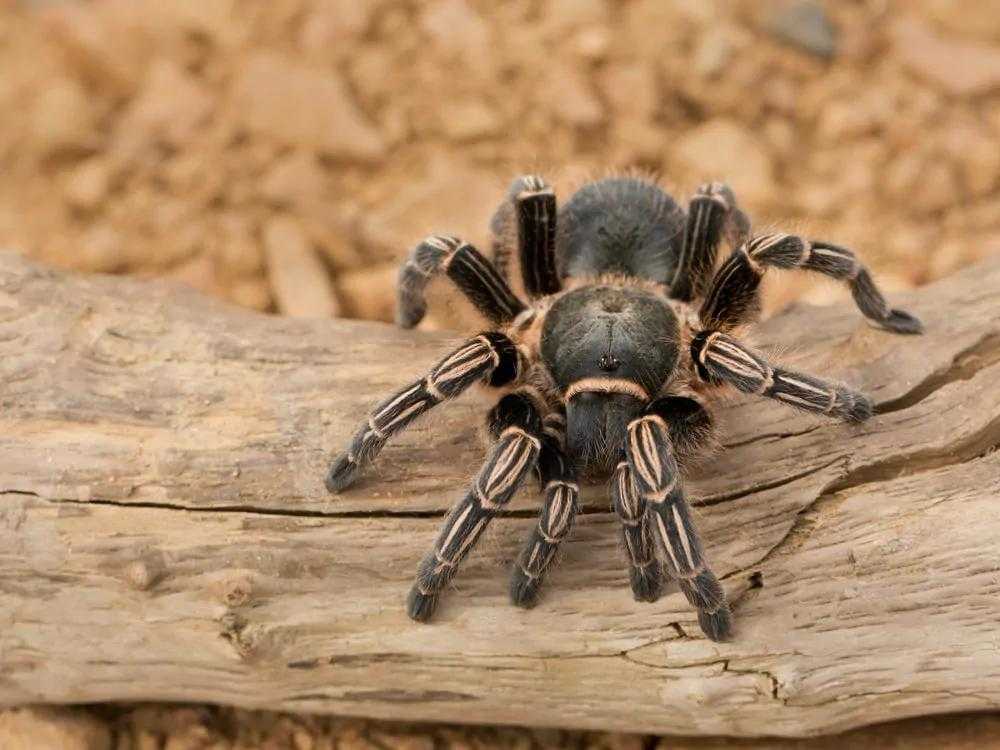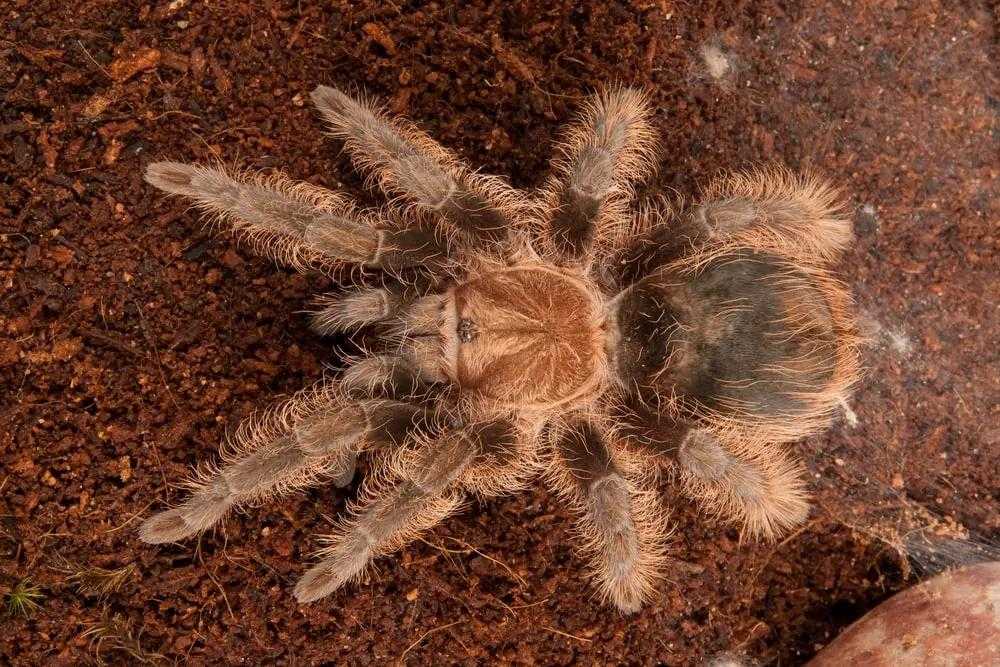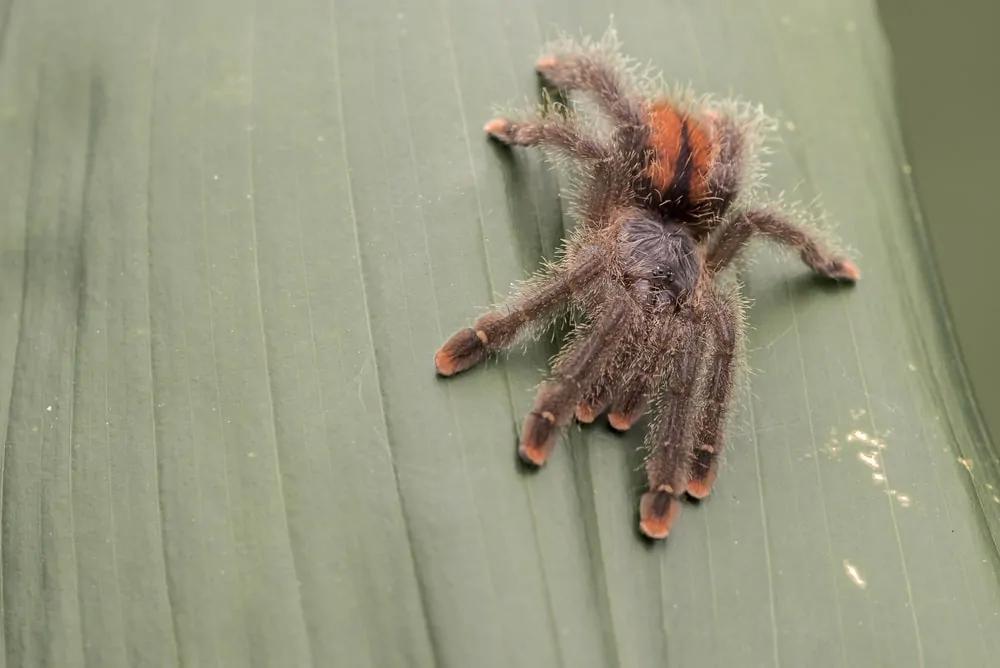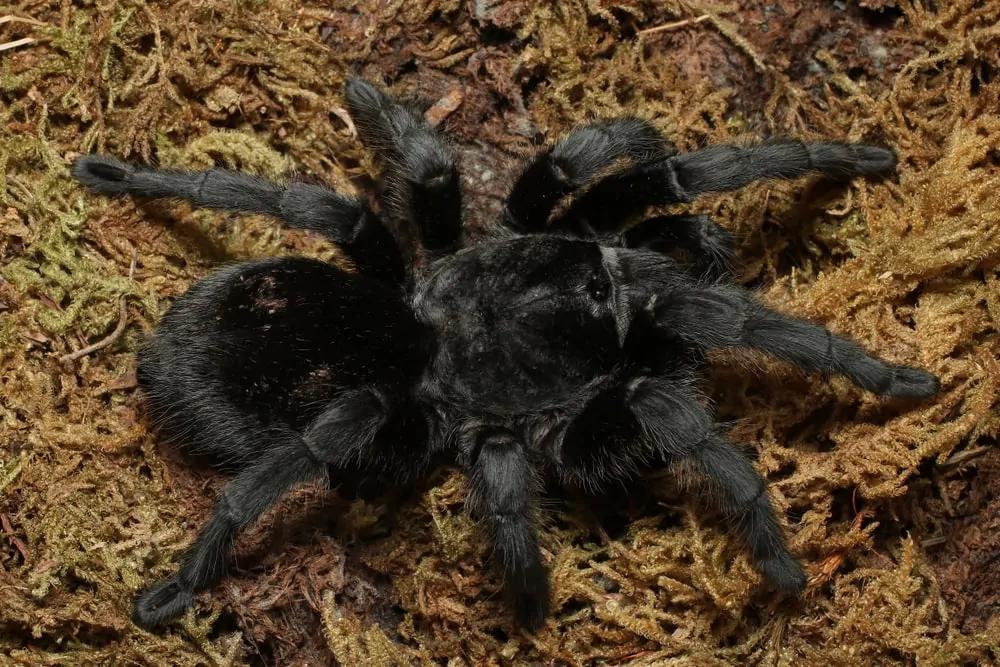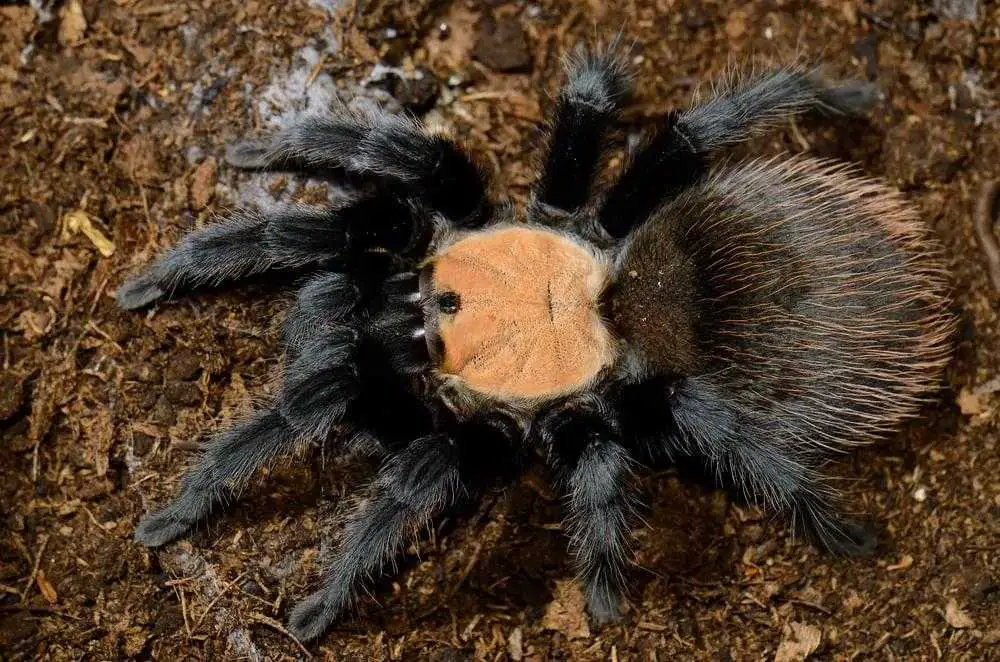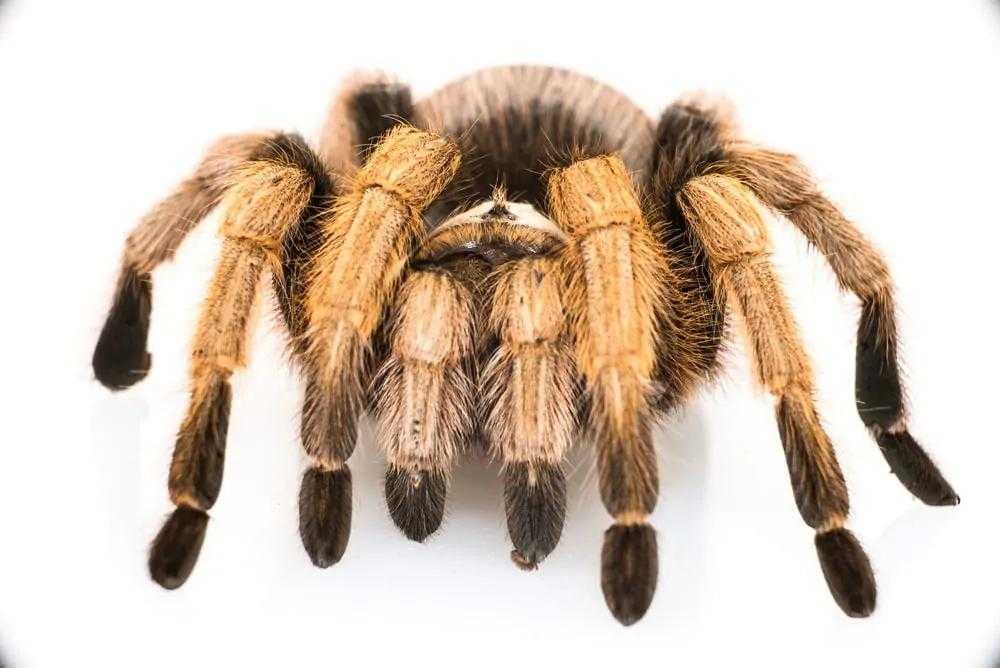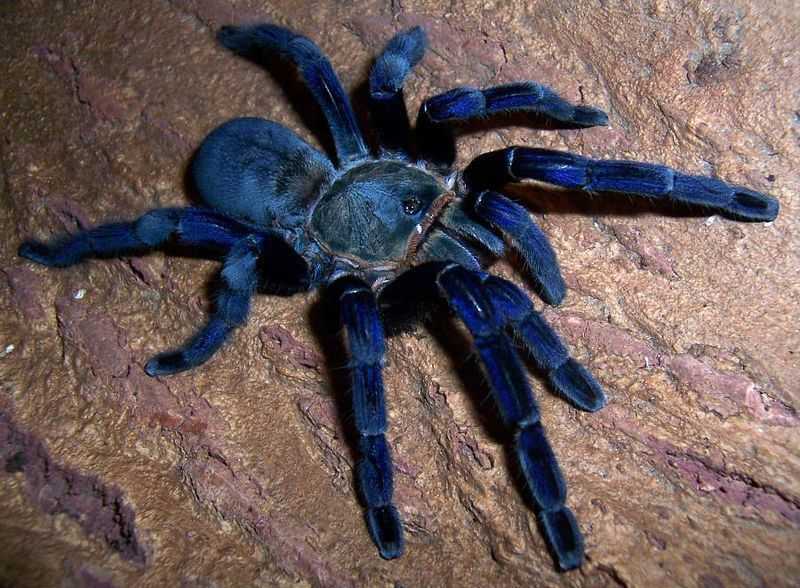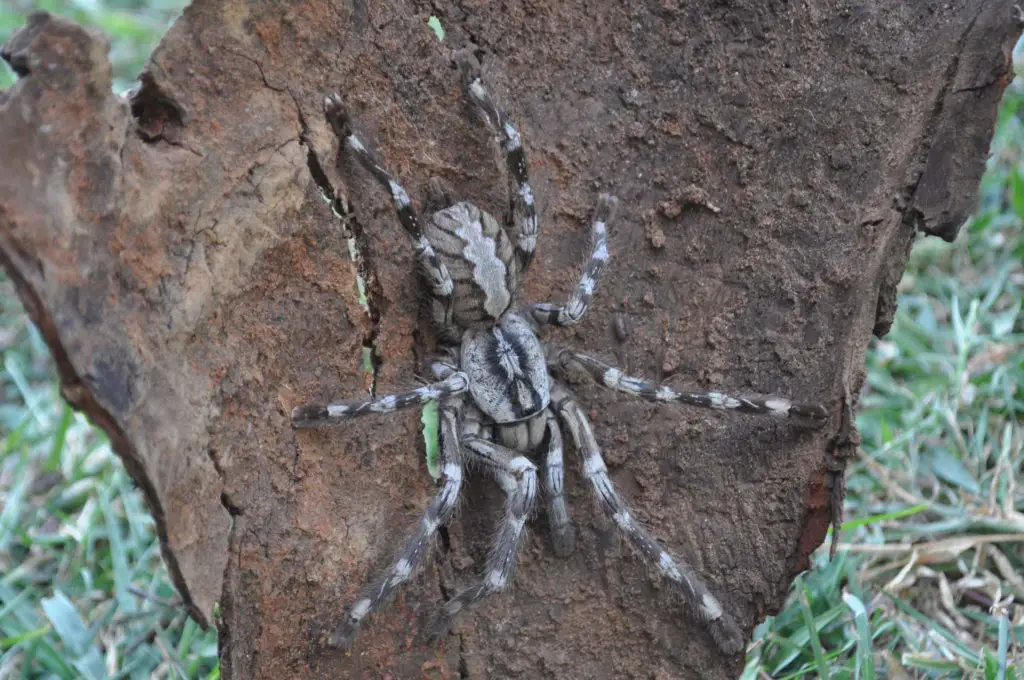Tarantulas are a group of hairy spiders that are quite large (and scary looking). There are over 1000 species of tarantulas. Some types of tarantulas are more popular than others. Some tarantula species are even kept as pets.
Contents
Types of Tarantulas
Mexican Redknee Tarantulas (Brachypelma smithi)
Species Overview:
- Length: 5 inches
- Weight: 0.5 ounce
- Appearance: Red-orange knees; black body with brown hairs
- Tank size: 5- to 10-gallons
- Kingdom: Animalia
- Phylum: Arthropoda
- Subphylum: Chelicerata
- Class: Arachnida
- Order: Araneae
- Infraorder: Mygalomorphae
- Family: Theraphosidae
- Genus: Brachypelma
- Species: B. smithi
The Mexican Redknee Tarantula is one of the most popular pet tarantulas. It is often the first pet for beginner spider collectors. These pet tarantulas can live up to 30 years (females live longer than males), have a leg span of about 5 inches, and, as the name suggests, have red knees. Mexican Redknee Tarantulas are also very calm and friendly spiders. They can be found living around different terrain types like the scrublands, deserts, deciduous forests, and dry thorn forests.
Chilean Rose Tarantulas (Grammostola rosea)
Species Overview:
- Length: 4 to 5 inches
- Weight: 0.5 ounce
- Appearance: Primarily black to brown; rose-colored hair on upper body
- Tank size: 10 gallons
- Scientific name: Grammostola rosea
- Kingdom: Animalia
- Phylum: Arthropoda
- Order: Araneae
- Family: Theraphosidae
- Genus: Grammostola
- Species: G. rosea
These kinds of tarantulas are also known as the Chilean Common, Chilean Fire, Chilean Rose Haired, and Chilean Flame tarantula. It is also a popular pet tarantula for beginner arachnid lovers. The average leg span is about 5 inches and females can live for up to 20 years. The Chilean Rose Tarantula is a burrowing spider and requires a warm and humid environment. This species of tarantula is known to be calm but they will fight each other.
Costa Rican Zebra Tarantulas (Aphonoplema seemanni)
Species Overview:
- Length: 4 to 5 inches
- Weight: 0.5 ounce
- Appearance: Black body; deep red hairs; white stripes on legs; orange spinnerets
- Tank size: 5- to 10-gallons
- Kingdom: Animalia
- Phylum: Arthropoda
- Subphylum: Chelicerata
- Class: Arachnida
- Order: Araneae
- Infraorder: Mygalomorphae
- Family: Theraphosidae
- Genus: Aphonopelma
- Species: A. seemanni
These types of tarantulas are a little bit smaller than the Chilean Rose, the Costa Rican Zebra only has a leg span of 4 to 4-1/2 inches. And, like the Chilean Rose, it is also a ground-dwelling species.
These tarantulas are calm but can be very fast (which may startle first-time pet owners). Females can live up to 20 years and the typical 70-85 degrees F temperatures are necessary, along with high humidity in the environment. They also go by the name, Striped-knee tarantula.
Mexican Redleg Tarantulas (Brachypelma emilia)
Species Overview:
- Length: 5 to 6 inches
- Weight: 0.5 to 1 ounce
- Appearance: Dark body; pink, red, or orange on the second joint of legs; light upper shell with a black triangle at the front
- Kingdom: Animalia
- Phylum: Arthropoda
- Subphylum: Chelicerata
- Class: Arachnida
- Order: Araneae
- Infraorder: Mygalomorphae
- Family: Theraphosidae
- Genus: Brachypelma
- Species: B. emilia
The Mexican Redleg tarantula can live up to 30 years and it can grow up to 6 inches. This species is also a ground-dwelling spider and is typically docile. However, Mexican Redlegs are easily startled.
If you want to keep them as pets, the recommended temperature range for this species is 75-85 degrees F, alongside the typical 65-70% humidity that most tarantulas need.
The Mexican redleg or red-legged tarantula is a species of terrestrial tarantula closely related to the famous Mexican redknee tarantula. Like the redknee it is a docile tarantula and popular in the pet trade. It is slow-growing and, like many tarantulas, females can live for decades.
Wikipedia
Honduran Curly Hair Tarantulas (Brachypelma albopilosum)
Species Overview:
- Length: 5.5 inches
- Weight: 0.5 to 1 ounce
- Appearance: Round body; short, dark bristles; long, golden bristles
- Tank size: 5- to 10-gallons
- Kingdom: Animalia
- Phylum: Arthropoda
- Subphylum: Chelicerata
- Class: Arachnida
- Order: Araneae
- Infraorder: Mygalomorphae
- Family: Theraphosidae
- Genus: Tliltocatl
- Species: T. albopilosus
The curly hair tarantula is a plump-bodied spider, covered with dark brown to black bristles. Also referred to as simply the curly hair or wooly tarantula, this spider is very hardy, slow-moving, and fast-growing. It is a ground-dwelling spider, like most of the good beginner tarantulas, and only needs a small enclosure, such as a 5 or 10-gallon habitat.
Pink Zebra Beauty Tarantula (Eupalaestrus campestratus)
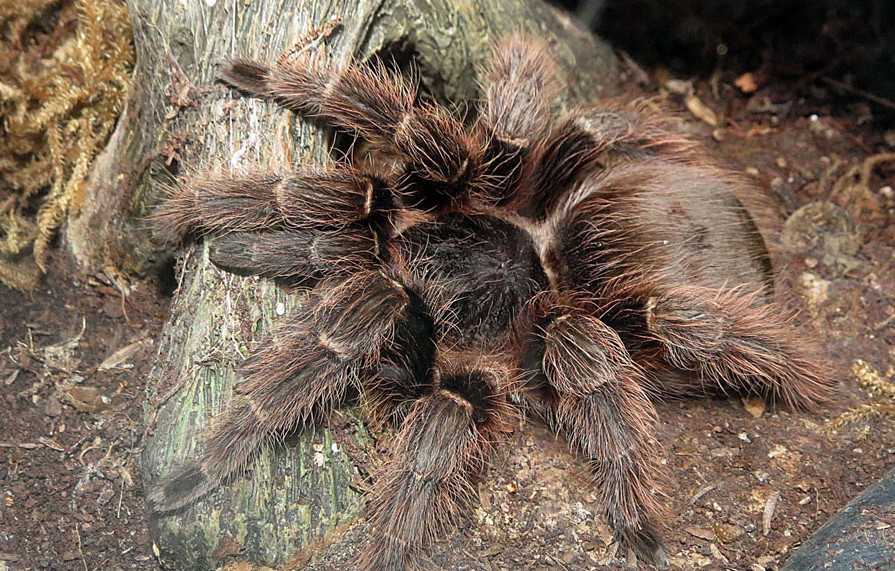
Species Overview:
- Length: 5 to 6 inches
- Weight: 0.5 to 1 ounce
- Appearance: Primarily dark brown; yellow striped markings
- Tank size: 5-10 gallons
- Kingdom: Animalia
- Phylum: Arthropoda
- Subphylum: Chelicerata
- Class: Arachnida
- Order: Araneae
- Infraorder: Mygalomorphae
- Family: Theraphosidae
- Genus: Eupalaestrus
- Species: E. campestratus
Like many tarantula species, the Pink Zebra Beauty is from South America. It’s a great choice for beginners looking for a pet spider. However, it is often confused with a different kind of spider called the Chaco Golden Knee. Females can live up to 25 years and they can grow to have a leg span of up to 6 inches. They typically have calm temperaments.
Pink Toe Tarantulas (Avicularia avicularia)
Species Overview:
- Length: 3.5 to 5 inches
- Weight: 0.5 ounce
- Appearance: Primarily black; pink-orange coloring at ends of furry legs
- Tank size: 10 gallons
- Kingdom: Animalia
- Phylum: Arthropoda
- Subphylum: Chelicerata
- Class: Arachnida
- Order: Araneae
- Infraorder: Mygalomorphae
- Family: Theraphosidae
- Genus: Avicularia
- Species: A. avicularia
The Pink Toe tarantula is also referred to as the Guyana Pink toe, Common Pink toe, South American Pink toe, or Pink-toed tree spider. This spider can have a leg span between 3-1/2 and 5 inches. However, females only live up to 10 years.
Housing for this type of tarantula is much different than a ground dweller since it is a tree-dwelling tarantula. It will need branches and more height to the enclosure to allow it to climb. Like most other tarantulas, pink toed are carnivores that will eat insects and other small creatures.
Brazilian Black Tarantulas (Grammostola pulchra)
Species Overview:
- Length: 7 inches
- Weight: 0.5 to 1 ounce
- Appearance: Primarily solid black; velvety hair
- Tank size: 5-10 gallons
- Kingdom: Animalia
- Phylum: Arthropoda
- Subphylum: Chelicerata
- Class: Arachnida
- Order: Araneae
- Infraorder: Mygalomorphae
- Family: Theraphosidae
- Genus: Grammostola
- Species: G. pulchra
A radiantly black and large spider with a long leg span, the Brazilian Black tarantula makes for a strikingly attractive pet. The females of this tarantula species can live up to 30 years and are known to eat about half a dozen crickets each week. It’s recommended that temperatures should be in the 70’s and humidity around 60% for this pet tarantula.
Mexican Red Rump Tarantulas (Brachypelma vagans)
Species Overview:
- Length: 6 inches
- Weight: 0.5 to 1 ounce
- Appearance: Primarily jet black; dark red hairs on the abdomen
- Tank size: 10 gallons
- Kingdom: Animalia
- Phylum: Arthropoda
- Subphylum: Chelicerata
- Class: Arachnida
- Order: Araneae
- Infraorder: Mygalomorphae
- Family: Theraphosidae
- Genus: Tliltocatl
- Species: T. vagans
Like other tarantula species, the Mexican Red Rump is easy to care for and grows to have a leg span of about 5 inches or more. These tarantulas are unusual because in the wild they tend to live near other Mexican Red Rumps, therefore if you are interested in having more than one tarantula, this is the species to choose.
Desert Blonde Tarantulas (Aphonopelma chalcodes)
Species Overview:
- Length: 5 to 6 inches
- Weight: 0.5 to 1 ounce
- Appearance: Blonde hairs on the upper shell and lower legs; black hairs on femurs; brown hairs on the abdomen
- Tank size: 10 gallons
- Kingdom: Animalia
- Phylum: Arthropoda
- Subphylum: Chelicerata
- Class: Arachnida
- Order: Araneae
- Infraorder: Mygalomorphae
- Family: Theraphosidae
- Genus: Aphonopelma
- Species: A. chalcodes
These types of tarantulas are somewhat more aggressive than the others on this list. However, the Desert or Mexican Blonde tarantula still makes a good option as a pet tarantula. This tarantula grows to be a little bit bigger than some others, but they do have similar care requirements when compared to most beginner tarantulas.
Cobalt Blue Tarantula (Cyriopagopus lividus)
Species Overview:
- Length: 5 inches
- Weight: 1 to 3 ounces
- Appearance: Iridescent blue legs, black and gray hairs
- Tank size: 10 gallons
- Kingdom: Animalia
- Phylum: Arthropoda
- Subphylum: Chelicerata
- Class: Arachnida
- Order: Araneae
- Infraorder: Mygalomorphae
- Family: Theraphosidae
- Genus: Cyriopagopus
- Species: C. lividus
Under certain lights, these Southeast Asian tarantulas are bright, brilliant blue. All other times, according to the Oakland Zoo, they look black. They are among the most aggressive types of pet tarantulas, and also one of the rarest. These species of tarantulas are not recommended to be kept as pets (especially not for beginners!). Bites from this species can result in severe muscle cramps and inflammation.
Goliath Bird-Eating Tarantula (Theraphosa blondi)

Species Overview:
- Length: 12 inches
- Weight: Up to 6 ounces
- Appearance: Tan to light brown and golden-hues
- Tank size: 30 gallons
- Kingdom: Animalia
- Phylum: Arthropoda
- Subphylum: Chelicerata
- Class: Arachnida
- Order: Araneae
- Infraorder: Mygalomorphae
- Family: Theraphosidae
- Genus: Theraphosa
- Species: T. blondi
This giant spider has a leg span of nearly 12 inches (30 cm), according to Blue Planet Biomes. It is native to Northern areas of South America and lives mostly in swampy areas. While the Goliath Bird-Eating tarantula can eat birds, the behavior is rare. The primary prey of this species is actually earthworms. They can be kept as pets but only for experienced pet owners (not recommended for beginners!).
Tiger spider (Poecilotheria rajaei)
Species Overview:
- Length: 8 inches
- Weight: Uknown
- Appearance: Yellow and gray piping on the first and fourth legs with a pink abdominal band
- Kingdom: Animalia
- Phylum: Arthropoda
- Subphylum: Chelicerata
- Class: Arachnida
- Order: Araneae
- Infraorder: Mygalomorphae
- Family: Theraphosidae
- Genus: Poecilotheria
- Species: P. rajaei
This is a newly discovered (found in 2009) species of spider that has a leg span of 8 inches (20 cm), according to Wired magazine. The tiger spider has enough venom to kill mice, lizards, small birds, and snakes. It was discovered on the island nation of Sri Lanka. It is a tree-dwelling spider. Not available as pet as it is an endangered and rare species.
Fun Facts
- Tarantulas belong to the Arachnid family which are invertebrates; these are types of animals that have no internal skeletal system.
- How many types of tarantulas are there? In the United States, there are 30 kinds of tarantulas. And, there are over 800 more documented species around the world.
- Can tarantulas kill humans? No, there have been no reports of a tarantula killing a human. Tarantulas do have venom but only enough to make their bite extremely unpleasant to a human.
- What do tarantulas eat? Butterflies, caterpillars, frogs, toads, beetles, gnats, birds, snakes, bats, etc.
- What is the best tarantula to have as a pet? Check out the list below to find out!
What’s The Friendliest Tarantula?
The Mexican red-knee is one of the friendliest tarantulas and often the first pet for spider enthusiasts. The females can live around 20 to 30 years while the males only live for about 10 years. A 5- to 10-gallon tank is suitable for these tarantulas. And as they’re very docile, they are easy to handle.
What Is The Most Aggressive Tarantula?
The most aggressive tarantula species is the famous Cobalt Blue Tarantula from Asia. They are popular among pet spider circle, because of their amazing blue coloring, but also famous for their short temper and aggressive behavior.
What Type Of Tarantula Is Best For Beginners?
Most pet tarantulas have the same basic care needs. The best species for a beginner are docile and easy to care for like:
- Mexican Redknee
- Mexican Redleg
- Chilean Rose
- Costa Rican Zebra
- Antilles Pink Toe
- Arizona Blonde
- Chilean Rose
- Brazilian Blacks
What Is The Cutest Tarantula?
The Mexican red knee tarantula is often considered to be the cutest spider in the world. Only because it is one of the most popular types of tarantulas kept as a pet.
Are Tarantulas Poisonous?
Tarantulas are not poisonous, but they do contain venom glands and inject venom into their prey through their fangs. These spiders are harmless to humans except for a painful bite and their mild venom is weaker than a typical bee’s.
References:
- Tarantula Facts – Live Science
- 10 Best Tarantula Species to Keep as Pets – Spruce Pets
- Keeping and Caring for Mexican Red-Knee Tarantulas as Pets
- How to Care for a Brachypelma Smithi (Mexican Red Knee)
- Mexican Redknee Tarantulas for Sale | Brachypelma smithi
- Are Tarantulas Poisonous?
- Difference Between Spider and Tarantula
- What Are Arachnids?
- Brachypelma smithi – Wikipedia
- Chilean Rose Hair Tarantula Care Guide
- Rose-haired Tarantula, Grammostola rosea, Chilean Rose Tarantula
- Chilean rose tarantula – Wikipedia
- CARE AND HUSBANDRY OF THE CHILEAN ROSE TARANTULA
- Chilean Rose Hair Tarantula (Behavior) – Ivzoo
- Aphonopelma seemanni – Wikipedia
- Costa Rican Zebra Tarantula (Aphonopelma seemanni)
- Tliltocatl albopilosus – Wikpedia
- 5 thoughts on “Brachypelma albopilosum”
- Keeping and Caring for Curly Hair Tarantulas as Pets – Spruce Pets
- Care for a Brachypelma Albopilosum (Honduran Curly Hair)
- Chaco Golden Knee Tarantula – Buffalo Zoo
- Chaco Golden Knee Tarantula – Cosley Zoo
- Eupalaestrus campestratus – Wikipedia
- Avicularia avicularia – Wikipedia
- Avicularia avicularia (Pink-toed Tarantula) – The UWI (St. Augustine) PDF
- Grammostola pulchra – Wikipedia
- Tliltocatl vagans – Wikipedia
- Keeping and Caring for Pet Desert Blonde Tarantulas – Spruce Pets
- Aphonopelma chalcodes – Wikipedia
- Cobalt Blue Tarantula (Cyriopagopus lividum) Care Sheet
- Cobalt blue tarantula – Wikipedia
- Goliath Birdeater – Description, Habitat, Image, Diet, and Interesting Facts
- Goliath birdeater – Wikipedia
- Tarantulas – National Geographic
- Poecilotheria rajaei – Wikipedia
- Friendliest Tarantula Species: What are the Most Docile Pet Tarantulas?
- https://en.wikipedia.org/wiki/Tarantula
Looking for more pets?
